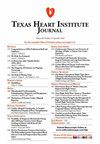Intra-Aortic Migration of a Clipped Epicardial Pacing Wire.
IF 0.9
4区 医学
引用次数: 2
Abstract
A 76-year-old man presented for electrophysiologic evaluation of a temporary pacemaker wire detected in his aorta. His medical history included coronary artery disease, 2-vessel coronary artery bypass grafting (CABG) 16 years previously, congestive heart failure (left ventricular ejection fraction, 0.35–0.40), hyperlipidemia, hypertension, frequent premature ventricular contractions, and singlechamber implantable cardioverter-defibrillator placement. His primary care physician had ordered chest computed tomograms to evaluate shortness of breath, chest pain, and hemoptysis. The images revealed mild infiltrative disease in the right upper lung lobe and a temporary pacemaker wire in the aortic arch. The proximal end of the wire terminated in the right ventricular wall, and the distal end was floating in the descending aorta (Fig. 1). Transesophageal echocardiograms (TEE) showed the wire in the lumen of the descending aorta (Fig. 2). At the time of CABG, the patient’s epicardial pacemaker wires had been clipped at skin level and left in place. From that time to the current presentation, he had experienced no stroke symptoms, nor had he undergone TEE or dedicated aortic scanning procedures until the current presentation. We concluded that the imaging findings were incidental. We then consulted our cardiac surgery colleagues regarding the high risks of percutaneous lead extraction, and they surmised that the epicardial lead had Images in Cardiovascular Medicine夹夹心外膜起搏导线的主动脉内移位。
本文章由计算机程序翻译,如有差异,请以英文原文为准。
求助全文
约1分钟内获得全文
求助全文
来源期刊

Texas Heart Institute Journal
CARDIAC & CARDIOVASCULAR SYSTEMS-
自引率
11.10%
发文量
131
期刊介绍:
For more than 45 years, the Texas Heart Institute Journal has been published by the Texas Heart Institute as part of its medical education program. Our bimonthly peer-reviewed journal enjoys a global audience of physicians, scientists, and healthcare professionals who are contributing to the prevention, diagnosis, and treatment of cardiovascular disease.
The Journal was printed under the name of Cardiovascular Diseases from 1974 through 1981 (ISSN 0093-3546). The name was changed to Texas Heart Institute Journal in 1982 and was printed through 2013 (ISSN 0730-2347). In 2014, the Journal moved to online-only publication. It is indexed by Index Medicus/MEDLINE and by other indexing and abstracting services worldwide. Our full archive is available at PubMed Central.
The Journal invites authors to submit these article types for review:
-Clinical Investigations-
Laboratory Investigations-
Reviews-
Techniques-
Coronary Anomalies-
History of Medicine-
Case Reports/Case Series (Submission Fee: $70.00 USD)-
Images in Cardiovascular Medicine (Submission Fee: $35.00 USD)-
Guest Editorials-
Peabody’s Corner-
Letters to the Editor
 求助内容:
求助内容: 应助结果提醒方式:
应助结果提醒方式:


